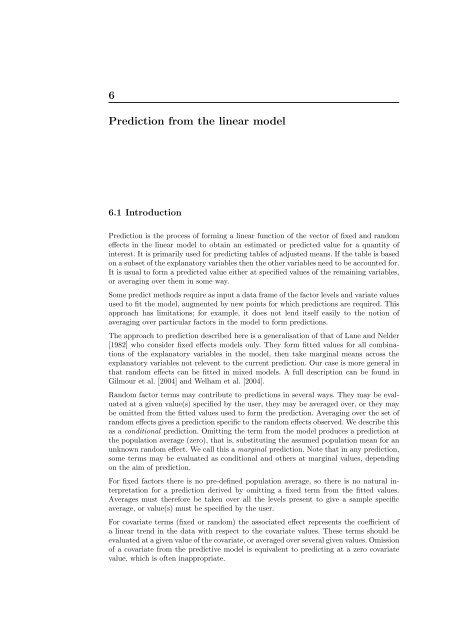ASReml-S reference manual - VSN International
ASReml-S reference manual - VSN International
ASReml-S reference manual - VSN International
- No tags were found...
Create successful ePaper yourself
Turn your PDF publications into a flip-book with our unique Google optimized e-Paper software.
6Prediction from the linear model6.1 IntroductionPrediction is the process of forming a linear function of the vector of fixed and randomeffects in the linear model to obtain an estimated or predicted value for a quantity ofinterest. It is primarily used for predicting tables of adjusted means. If the table is basedon a subset of the explanatory variables then the other variables need to be accounted for.It is usual to form a predicted value either at specified values of the remaining variables,or averaging over them in some way.Some predict methods require as input a data frame of the factor levels and variate valuesused to fit the model, augmented by new points for which predictions are required. Thisapproach has limitations; for example, it does not lend itself easily to the notion ofaveraging over particular factors in the model to form predictions.The approach to prediction described here is a generalisation of that of Lane and Nelder[1982] who consider fixed effects models only. They form fitted values for all combinationsof the explanatory variables in the model, then take marginal means across theexplanatory variables not relevent to the current prediction. Our case is more general inthat random effects can be fitted in mixed models. A full description can be found inGilmour et al. [2004] and Welham et al. [2004].Random factor terms may contribute to predictions in several ways. They may be evaluatedat a given value(s) specified by the user, they may be averaged over, or they maybe omitted from the fitted values used to form the prediction. Averaging over the set ofrandom effects gives a prediction specific to the random effects observed. We describe thisas a conditional prediction. Omitting the term from the model produces a prediction atthe population average (zero), that is, substituting the assumed population mean for anunknown random effect. We call this a marginal prediction. Note that in any prediction,some terms may be evaluated as conditional and others at marginal values, dependingon the aim of prediction.For fixed factors there is no pre-defined population average, so there is no natural interpretationfor a prediction derived by omitting a fixed term from the fitted values.Averages must therefore be taken over all the levels present to give a sample specificaverage, or value(s) must be specified by the user.For covariate terms (fixed or random) the associated effect represents the coefficient ofa linear trend in the data with respect to the covariate values. These terms should beevaluated at a given value of the covariate, or averaged over several given values. Omissionof a covariate from the predictive model is equivalent to predicting at a zero covariatevalue, which is often inappropriate.
















